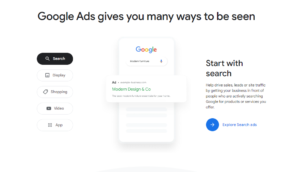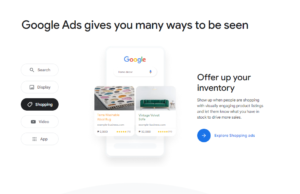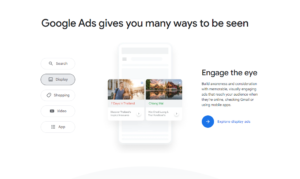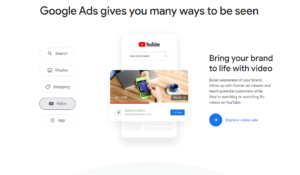______________________
Welcome to Richard’s guide on Google Ads in 2024, where we’ll delve into the intricacies of digital advertising and explore the diverse array of campaigns available to businesses seeking to maximize their online presence. In today’s rapidly evolving digital landscape, understanding the nuances of Google Ads is crucial for any business aiming to reach its target audience effectively. So, let’s embark on this journey together and unlock the potential of Google Ads.
Understanding the Campaign Landscape
The first step in harnessing the power of Google Ads is gaining a thorough understanding of the various campaign types at your disposal. Each campaign serves a distinct purpose and utilizes different ad formats tailored to specific business objectives and target audiences.
Search Campaigns:
Search campaigns are the cornerstone of Google Ads, focusing on text-based ads displayed within the search network. Ideal for service-based or software businesses, they offer flexibility in targeting both new and existing clients, as well as remarketing opportunities.
Performance Max:
Performance Max campaigns represent the evolution of digital advertising, encompassing text, shopping, image, Google Maps, and Gmail ads across multiple networks. It is suitable for a wide range of businesses. They leverage Google’s AI capabilities to optimize campaigns for maximum performance.
Shopping Campaigns:
Shopping campaigns feature product listings tailored to showcase physical products to potential customers, catering to both new and existing clients. They are designed primarily for e-commerce businesses,
Display Campaigns:
Display ads, characterized by visually compelling imagery, target audiences across websites and apps within the Google Display Network. They offer versatility in targeting both new clients and remarketing to existing audiences.
Discovery Campaigns:
These image-based ads are geared towards introducing new clients to your business across platforms like YouTube, Gmail, and the App Store, focusing on expanding your customer base.
Video Campaigns:
Harnessing the power of video content, these campaigns deliver engaging ads on YouTube, catering to new clients while offering remarketing opportunities and channel-specific targeting.
App Campaigns:
These campaigns leverage text and image ads across Google Play, search, YouTube, and the Discovery network, driving app downloads and user engagement — Targeted at promoting mobile applications.
Targeting and Control
In addition to understanding the different campaign types, it’s essential to consider the level of control and targeting options available within each campaign. From keyword targeting to ad copy customization, the degree of control varies across campaigns, influencing their suitability for different business needs.
Conversion Endpoints
When planning your Google Ads strategy, identifying the desired conversion endpoints is crucial. Whether it’s email sign-ups, form completions, online bookings, sales, or app downloads, aligning your campaign objectives with specific conversion goals ensures optimal performance and ROI.
Budget Considerations
Finally, budget considerations play a pivotal role in determining the feasibility and effectiveness of your Google Ads campaigns. Campaigns like Performance Max require substantial budgets to leverage Google’s AI effectively, while search and shopping campaigns offer more accessible entry points for businesses with limited budgets, allowing for gradual scalability as resources permit.
______________________
Optimizing Ad Targeting: Broad vs. Niche Strategies
One crucial aspect of running a successful advertising campaign — identifying your target audience and managing your budget effectively. between the scope of your target audience and the impact on your ad costs. It’s clear that casting a wider net often translates to more cost-effective ads. Why? Well, when you’re targeting a broad audience, you’re competing with a larger pool of advertisers, which can drive down the cost per click or conversion.
On the flip side, honing in on specific demographics can ramp up your ad expenses. For instance, if you’re aiming your ads solely at a particular city or demographic group, you’re likely to face higher competition and, consequently, higher costs.
But here’s where it gets interesting: you have the power to exclude certain locations or demographics from your ad targeting. Which means you can tailor your campaigns to reach the most relevant audience for your business while avoiding unnecessary expenses in areas where you don’t operate or target.
Now, let’s talk audience segments. It’s crucial to select the right parameters for your target audience based on factors like parental status, education, homeownership, employment, and industry. However, tread lightly here. While it’s tempting to get hyper-specific with your targeting, going too niche can actually drive up your ad costs.
In essence, finding the perfect balance between broad and niche targeting is key to optimizing your ad campaigns for cost-effectiveness and reaching your desired audience effectively.
In our exploration of the economic ramifications of Google Search and Ads, we draw insights from the research available on https://economicimpact.google/. Firstly, we posit that for every dollar poured into Google Ads, businesses rake in an average of $2 in revenue. This insight, crafted by our esteemed chief economist, Hal Varian, derives from meticulous scrutiny of cost-per-click trends among our advertisers. Varian’s meticulous methodology, unveiled in the hallowed pages of the American Economic Review back in May 2009, lends weight to this assertion.
The other one revolves around the notion that, on average, businesses garner five clicks on their search results for every solitary click on their ads.
Conclusion
Mastering Google Ads is paramount for businesses who strive to stay ahead and reach their target audience effectively. By understanding the diverse range of campaign options, targeting capabilities, conversion endpoints, and budget considerations, businesses can craft a tailored Google Ads strategy that drives tangible results and propels them toward success in 2024 and beyond.




